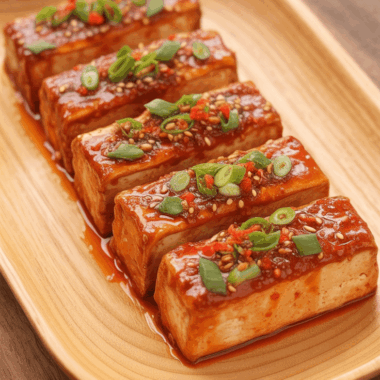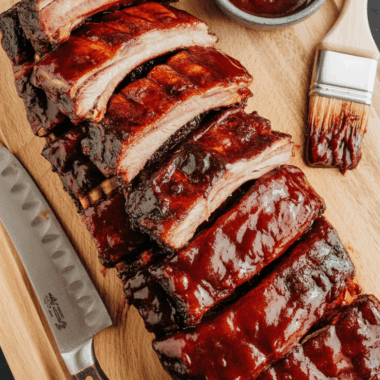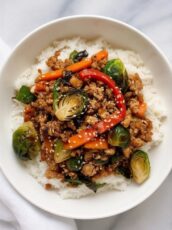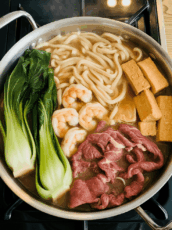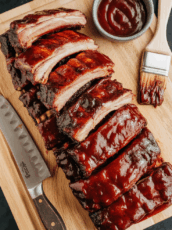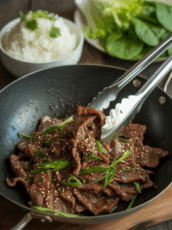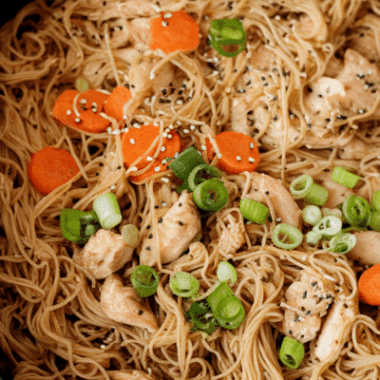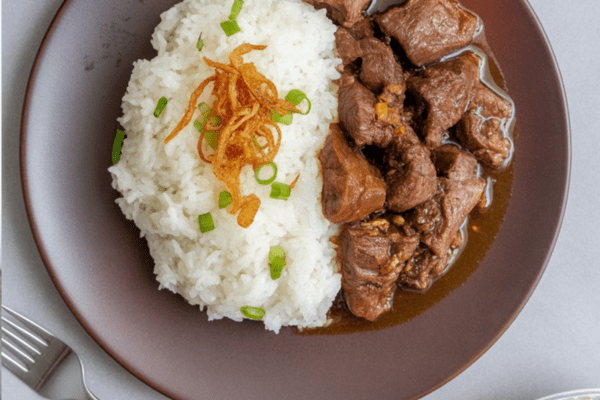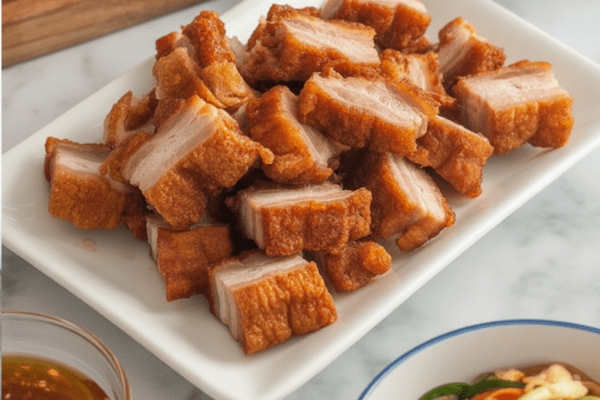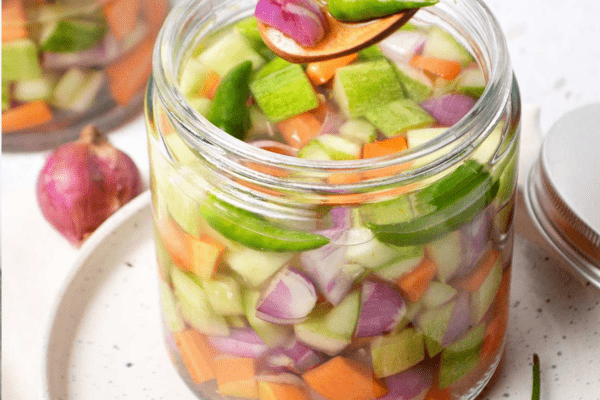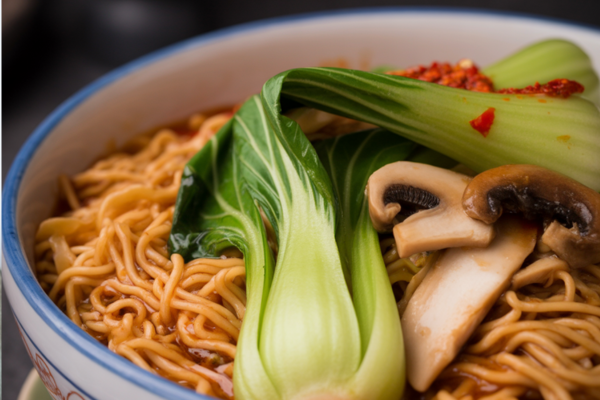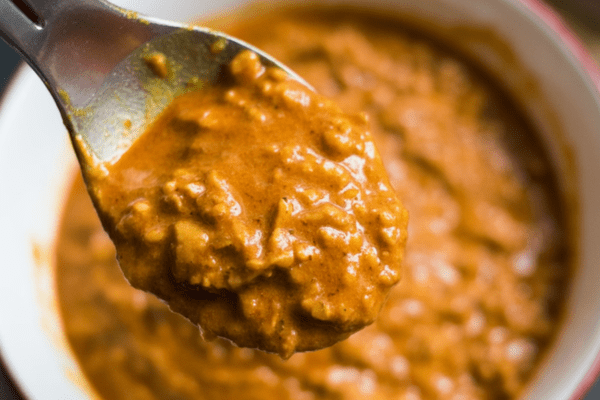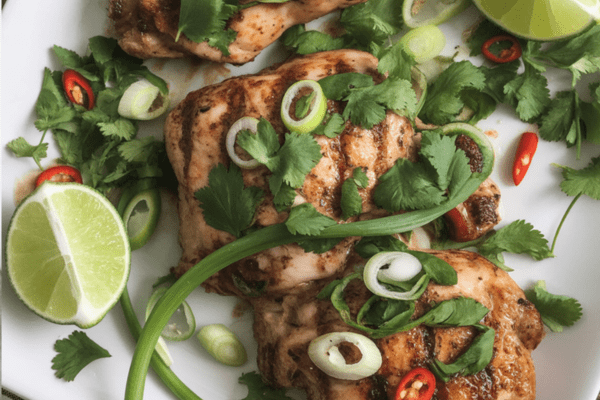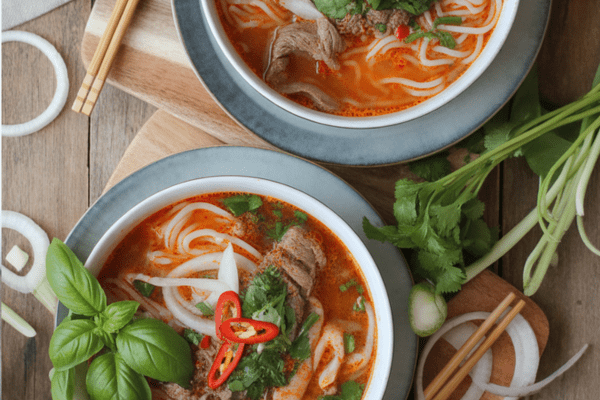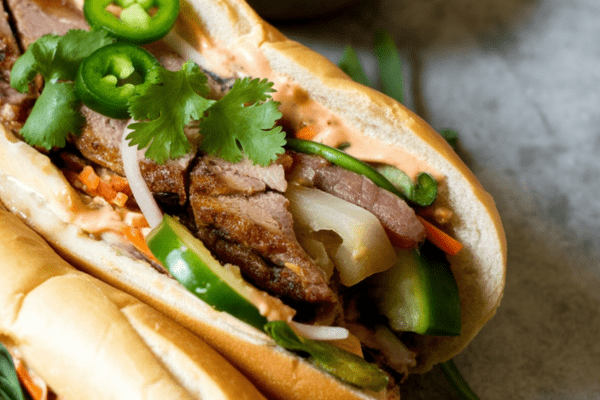If I had to pick one Korean dish that never disappoints, it’s this—spicy pork bulgogi, or jeyuk bokkeum. It’s one of those meals that feels like a reward at the end of a long day. Sliced pork, tossed in a rich, spicy-sweet gochujang sauce, stir-fried until everything’s slightly caramelized and smoky… and all it needs is a bowl of rice to turn into a deeply satisfying dinner.
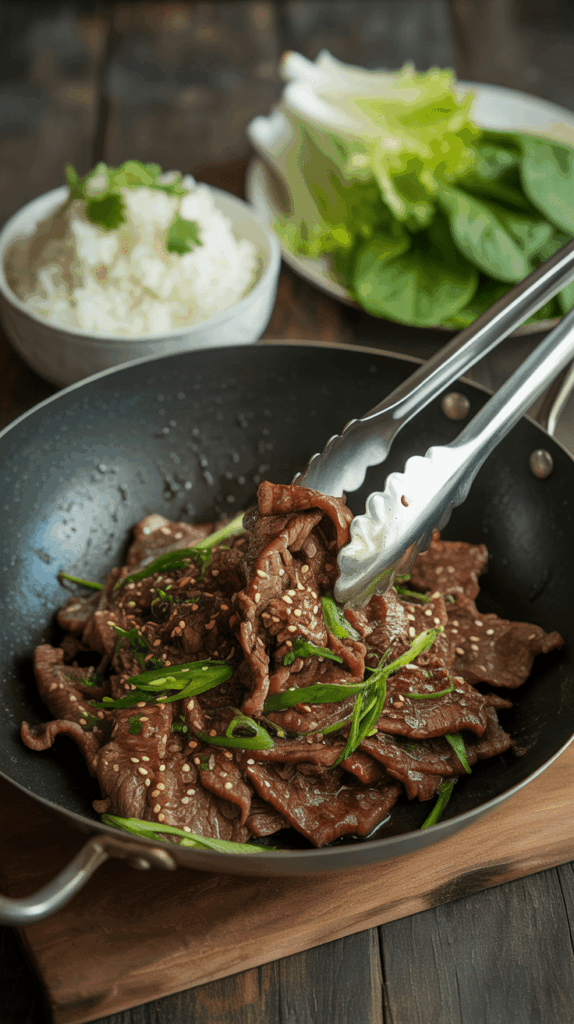
Back when I first tried it at a little Korean spot tucked behind a busy market street, I remember thinking: how can something this fast taste like it’s been cooked for hours? It’s bold and cozy at the same time. Once I figured out how to recreate that flavor at home—without needing a fancy grill—I knew it was going to become a regular on my dinner rotation.
What Makes This Version So Good
That Smoky, Caramelized Flavor
Here’s a trick I swear by: instead of relying on long marinades (which sometimes don’t hit the mark anyway), I caramelize a bit of sugar in oil with leeks or green onions before adding the pork. It’s like creating a shortcut to that slightly charred Korean BBQ flavor—right on the stovetop.
If you’ve ever had jeyuk bokkeum that tasted flat or watery, this step changes everything. It gives the meat that deep color and sticky edges you usually only get from a hot grill.
No Waiting Around
Look, we all love the idea of marinating overnight, but on a weeknight when you just want to get food on the table, it’s not happening. That’s why I love this version—you can toss everything together and start cooking right away. Of course, if you’ve got time, marinate it longer. But honestly? Even a quick mix gives you all the flavor you need.
Let’s Talk Ingredients
For the pork, I always go for something with a little fat—pork shoulder or pork butt works beautifully. Thin slices soak up the sauce quickly and stay juicy as they cook. I usually ask my butcher to slice it thin for me, but you can also freeze the meat for 30–40 minutes and slice it yourself with a sharp knife.
As for the sauce, it’s a punchy mix of gochujang (Korean chili paste), gochugaru (chili flakes), soy sauce, sugar, garlic, ginger, and a splash of sesame oil. That little combo right there is gold—bold, slightly sweet, spicy, and nutty.
Sometimes, I’ll swap in chicken thighs if that’s what I have on hand, or tofu if I’m keeping things meatless. It’s super flexible, and the sauce really makes everything taste great.
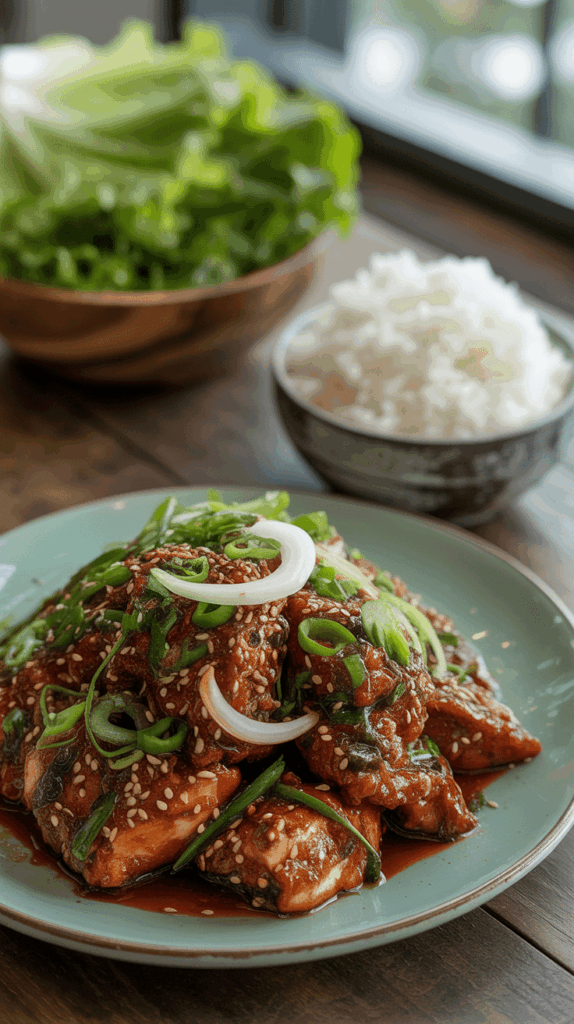
Quick Step-by-Step: How I Make It
- Mix the Marinade: Grab a big bowl and combine gochujang, gochugaru, soy sauce, sugar, garlic, ginger, sesame oil, rice wine, and sesame seeds. Toss in the pork and let it sit while you prep the pan.
- Caramelize the Sugar: Heat a bit of oil in a wok or large skillet. Add a spoonful of sugar and let it melt until golden. Don’t walk away—this happens fast.
- Add Leeks or Green Onion: Toss in the chopped leeks or scallions and stir-fry just until they soften and start to smell amazing.
- Cook the Pork: Add your marinated pork and sliced onion. Spread it out so it sears instead of steaming. Stir-fry until it’s cooked through and the sauce thickens and clings to the meat.
And that’s it. The whole thing comes together in 15–20 minutes flat.
How I Like to Serve It
For me, jeyuk bokkeum is one of those meals where I don’t need anything fancy—just a bowl of hot rice and maybe a quick cucumber salad or kimchi on the side. But if I’m feeling a little extra, I love making lettuce wraps with it. Wrap a piece of pork in green leaf lettuce or perilla leaves, add a dab of ssamjang (fermented soybean paste sauce), maybe a slice of garlic or chili, and pop the whole thing in your mouth. It’s messy, but in the best way.
Sometimes I’ll serve it with a simple doenjang jjigae (soybean paste stew) for a more complete spread—it’s something I picked up from a Korean family dinner I was invited to once, and I’ve never looked back.
Tips That’ve Helped Me Nail It
- Thinly sliced meat cooks fast and absorbs flavor quickly. Keep your slices uniform so they cook evenly.
- Caramelizing sugar before adding meat adds that little something special—kind of like wok hei in Chinese stir-fries.
- Don’t overcrowd the pan. If your pan’s too full, the pork will steam instead of sear. Cook in batches if needed.
- Gochujang varies in sweetness and heat. Taste your marinade and adjust sugar or chili flakes to your liking.
Make-Ahead Notes
If I know I’ll be short on time later in the week, I’ll mix the marinade and pork in the morning and stash it in the fridge. It actually gets better as it sits. You can also slice and freeze the pork in portions with marinade for meal prep—just defrost and cook.

How to Store Leftovers
Leftovers? Rare in my house, but when it happens, I pack it up in an airtight container and store it in the fridge for up to 3 days. Reheat it gently in a skillet—add a splash of water if it’s looking dry.
This also makes a pretty killer lunch the next day, especially wrapped in rice paper or tucked into a warm tortilla for a spicy fusion wrap.
Common Questions
Can I make this less spicy?
Sure! Just reduce the amount of gochugaru and add a little more sugar or soy sauce. You’ll still get plenty of flavor without the full heat.
Is it okay to use pork belly?
Yes, if you’re after something richer and don’t mind a little extra fat. I’ve made it with pork belly slices for special occasions, and it’s absolutely indulgent.
What’s the best gochujang brand to use?
Use what you can find. I’ve used everything from classic supermarket tubs to homemade versions from Korean grocery stores. The key is to taste and adjust the marinade—it’s all about balance.
This is the kind of dish that keeps me coming back to Korean flavors—bold, comforting, and surprisingly simple. If you give this spicy pork bulgogi a try, don’t forget to make a little extra rice… you’ll need it.
Let me know how it turns out for you. I’d love to hear your version.
Spicy Pork Bulgogi (Jeyuk Bokkeum)
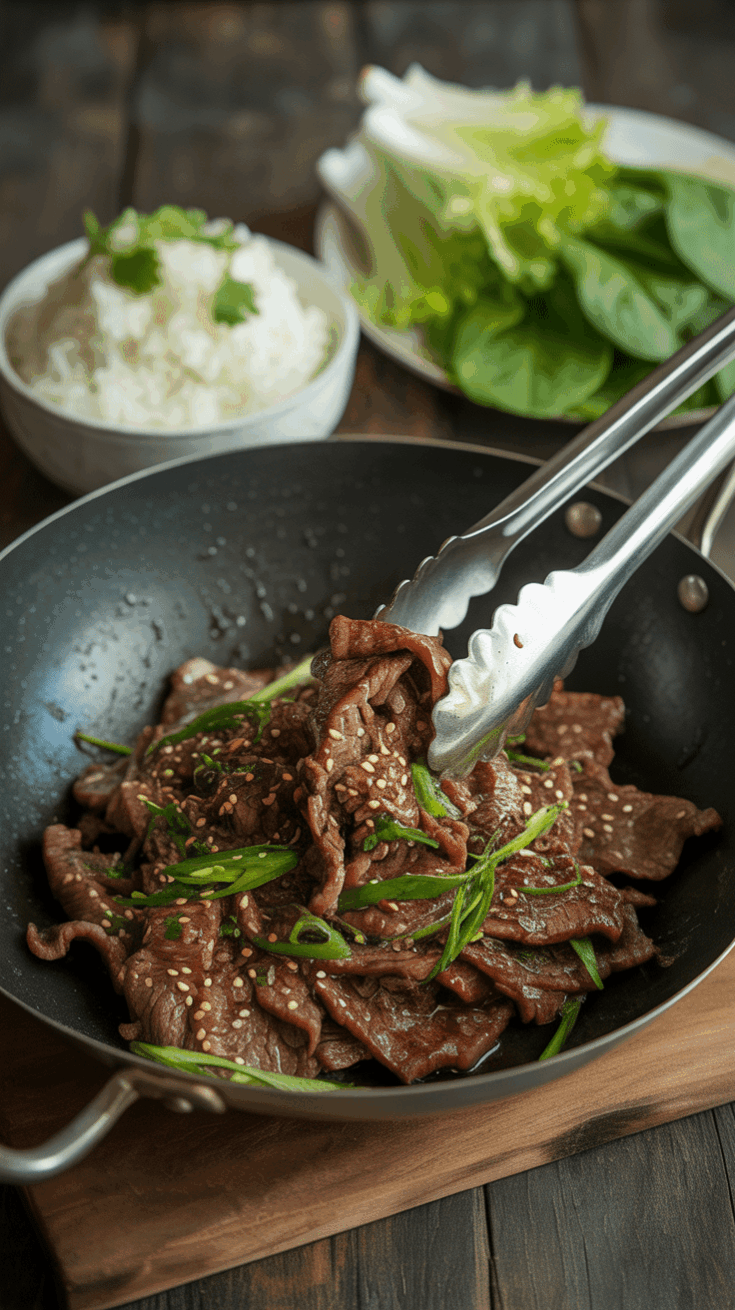
When you're craving bold flavors and a quick meal that feels like it came straight from a sizzling Korean BBQ table, this spicy pork bulgogi is the answer.
Ingredients
For the pork:
- 2 tbsp canola oil
- 2 tsp sugar (for caramelizing)
- 1/2 large onion, thinly sliced
- 1 Asian leek (or 4 green onions), chopped
- 2 lb pork shoulder or pork butt, thinly sliced
For the marinade:
- 6 tbsp gochujang (Korean chili paste)
- 2 tbsp sugar
- 2 tbsp soy sauce
- 1–2 tbsp gochugaru (Korean chili flakes)
- 2 tbsp mirin (sweet rice wine)
- 3 cloves garlic, minced
- 1 1/2 tsp ginger paste
- 1 1/2 tsp ginger paste
- 1 tbsp sesame oil
- 1 tbsp sesame oil
- 1 tbsp toasted sesame seeds
- 1 tbsp toasted sesame seeds
- 1/2 tsp black pepper
- 1/2 tsp black pepper
Instructions
- Mix the Marinade: In a bowl, stir together gochujang, gochugaru, soy sauce, mirin, sugar, garlic, ginger, sesame oil, sesame seeds, and black pepper until smooth and combined.
- Prepare the Pork: Place the thinly sliced pork into a large mixing bowl, making sure to separate the slices so they’re not clumped together. Pour the marinade over the pork and massage it in well. (Wearing gloves helps!) You can marinate for up to 24 hours in the fridge for deeper flavor, or cook it right away if short on time.
- Caramelize the Sugar: Heat a large skillet or wok over high heat. Add the canola oil and sprinkle in the sugar. Let it melt and bubble until it starts to caramelize and deepen in color.
- Aromatics First: Toss in the chopped leek or green onion and give it a quick stir to flavor the oil—about 30 seconds.
- Stir-Fry the Pork: Add the marinated pork and sliced onion to the hot pan. Stir-fry briskly for 3–4 minutes until the pork is cooked through and tender, and the edges are slightly charred.
- Serve Hot: Plate immediately with steamed rice or alongside lettuce leaves for wrapping.
Notes
- Slice Like a Pro: For thin slices, freeze the pork slightly before cutting—it makes the job easier and more uniform.
- Get That Sear: High heat is essential. It prevents sogginess and adds a touch of smoky char.
- Use the Right Pan: A cast-iron skillet or carbon steel wok holds heat best. Nonstick pans won’t give you the same depth of flavor.
- Avoid Overcrowding: Cook in batches if needed—piling it all in at once can lead to steaming, not searing.
Nutrition Information:
Yield: 8 Serving Size: 1Amount Per Serving: Calories: 494Total Fat: 32gSaturated Fat: 10gTrans Fat: 0gUnsaturated Fat: 19gCholesterol: 111mgSodium: 977mgCarbohydrates: 19gFiber: 1gSugar: 14gProtein: 30g
Asianplated.com, occasionally offers nutritional information for recipes contained on this site. This information is provided as a courtesy and is an estimate only. This information comes from online calculators. Although allchickenrecipes.com attempts to provide accurate nutritional information, these figures are only estimates.
Try other Korean recipes:

